WILL THE WORLD END IN 2012?
December 21, 2012. The Internet, bookshelves, and movie theaters are full of prophecies, theories, and predictions that this date marks the end of the world, or at least the end of the world as we know it.
Whether the end will result from the magnetic realignment of the north and south poles, bringing floods, earthquakes, death, and destruction; or from the return of alien caretakers to enlighten or enslave us; or from a global awakening, a sudden evolution of Homo sapiens into non corporeal beings theories of great, impending changes abound.
WILL THE REALLY END IN 2012?
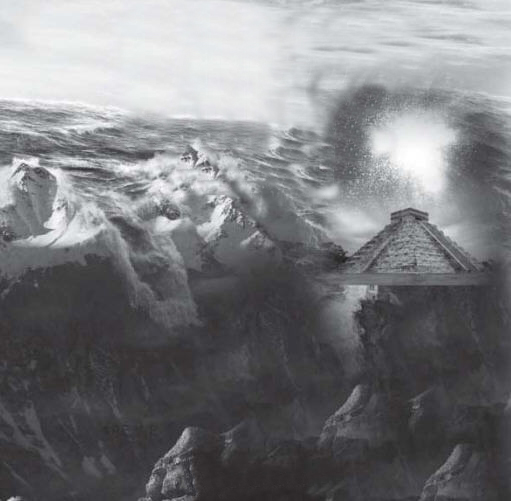
Will there be tsunamis rising higher than the Himalayas?
Will there be massive earthquakes, erupting volcanoes and meteors falling from the sky?
NASA’s Ask an Astrobiologist Website, for example, has received thousands of questions regarding the 2012 doomsday predictions some of them disturbing, according to David Morrison, senior scientist with the NASA Astrobiology Institute.
“A lot of [the submitters] are people who are genuinely frightened,” Morrison said.
“I’ve had two teenagers who were considering killing themselves, because they didn’t want to be around when the world ends,” he said. “Two women in the last two weeks said they were contemplating killing their children and themselves, so they wouldn’t have to suffer through the end of the world.”
What exactly is going to happen in December 2012? The fact is that no one exactly knows the answer. The particular year itself is derived from the Mayan Calendar.
WHO ARE THE MAYANS?
The Maya civilization thrived in Central and South America from around 3000 BC. Their dynamic and intelligent culture survived for thousands of years but finally collapsed during an intense 200 year drought, not long before Christopher Columbus landed on America’s shores in the 15th century.
The Mayans are known for their advanced written language, as well as their art, architecture, maths and astronomy. They used a base 20 and base 5 numbering system, and independently created the concept of zero by 36 BC.
This capacity for numbers produced highly accurate astronomical observations, charting the movements of the moon and other planets. Based on their own astrology, the resulting Mayan calendar was one of prophecies, and supporters of the Mayan 2012 theory point to several seemingly accurate predictions to date.
As one of the best examples of indigenous Mesoamerican cultures, the Mayans are often credited with being one of the most advanced of all cultures found in the Americas. Credited with being the first culture in the New World to utilize a fully developed written language, as well as being innovators in art, architecture, and the sciences of mathematics and astronomy, the Mayan people were not necessarily known as inventors. Instead Mayan culture seemed to promote the application of the creations of many of the other cultures in the area and finding ways to improve upon those basic developments. From this perspective, the influence of the Maya can be found in many places around Mexico and other parts of Central America, with artifacts that are decidedly of Mayan origin being found as far away as central Mexico.
During the Classic period, monumental architecture and stelae with historical records were erected. On these monuments the Maya rulers reigned as divine kings. The Maya thrived during the Late Classic (AD 550 900), and art, architecture, writing, commerce and intensive agricultural practices flourished all through the Maya lands. More than 2 million people may have lived in the area, and it is estimated that Tikal, the largest center, had a population of 75,000 to 100,000.
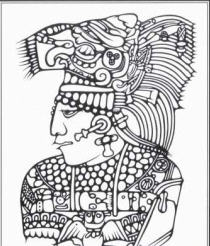
However, the Classic Maya cities did not survive into the 10th century. It seems that the system of rule that had served them well for centuries failed. Probably faced with famine, foreign invasion, chronic warfare, adverse climatic conditions and perhaps disease, the Classic period ended in what is called the Classic Maya collapse.
Maya historian David Webster is very critical about the whole hype. He explains, “Already on our cultural horizon is the next big abuse of the Classic Maya predictions of Doomsday. Archaeologists have long known that the current big cycle in the Long Count Calendar (called the 13th baktun, an interval of about 400 years) will end on December 21, 2012, a date that the wider world has recently discovered. Google 2012 and the word Maya into the search engine of your computer (I’ve recently examined two books found this way), and you will be flooded with predictions one set promising a sudden rebirth of human spirituality or, in a more sinister vein, the end of the world, or at least of civilization. This momentous date has purportedly been found in the Chinese I Ching, The Book of Revelations, the medieval predictions of Merlin (whatever those are), and many other prophetic works. Malevolent alignments of planets and stars are said to coincide with it. Websites, books, television documentaries, and movies are sensationalizing the impending event, and the crescendo will intensify over the next few years. The Maya, of course, would simply have begun another cycle, just as they did before, and their world would have gone on.
Here’s my prediction: 2012 will come and go without the world falling apart (at least any faster than it is at present), and people will forget about this particular intrusion of the ancient Maya into our lives.
Nevertheless, long after 2012, we will still be fascinated with the Classic Maya. We will continue to use and abuse them for our own purposes, and see our own fate as somehow linked with their own. Each generation gets the Maya it deserves, or thinks it wants.
WHAT DOES THE MAYAN CALENDAR PREDICT?
The Maya calendar doesn’t end in 2012, as some have said, and the ancients never viewed that year as the time of the end of the world, archaeologists say.
But December 21, 2012, (give or take a day) was nonetheless momentous to the Maya. “It’s the time when the largest grand cycle in the Mayan calendar 1,872,000 days or 5,125.37 years overturns and a new cycle begins,” said Anthony Aveni, a Maya expert and archaeoastronomer at Colgate University in Hamilton, New York. The Maya kept time on a scale few other cultures have considered. During the empire’s heyday, the Maya invented the Long Count a lengthy circular calendar that “transplanted the roots of Maya culture all the way back to creation itself .”
During the 2012 winter solstice, time runs out on the current era of the Long Count calendar, which began at what the Maya saw as the dawn of the last creation period: August 11, 3114 B.C. The Maya wrote that date, which preceded their civilization by thousands of years, as Day Zero, or 13.0.0.0.0.
In December 2012, the lengthy era ends and the complicated, cyclical calendar will roll over again to Day Zero, beginning another enormous cycle.
IS ANYTHING ELSE GOING TO HAPPEN?
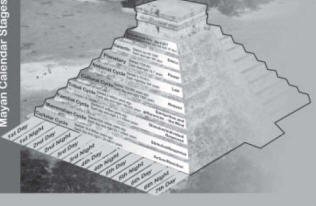
Oh, yes! Once it was clear that nothing is clear, a lot of people have jumped on the bandwagon and this is what they have warned about:
What can/will/may happen?
Here’s the list of 2012 events:
• Pole shift
• Magnetic pole reversal
• Planet X getting near earth or hitting earth
• Meteor hitting earth (thanks to Nostradamus)
• Planetary alignment leading to a major gravity burst with earth being swallowed by the center of the galaxy.
• New dimensions opening
The line between reality and illusion is rapidly getting blurred. There are plenty of naysayers who emphatically state that planetary alignments are a very slow, gradual process. Magnetic evidence in rocks confirms that continents have undergone such drastic rearrangement, but the process took millions of years slow enough that humanity wouldn’t have felt the motion. NASA’s Morrison opines about the “galactic alignment”:
“There is no ‘galactic alignment’ in 2012,” he said, “or at least nothing out of the ordinary.” Similarly, when asked about the mysterious planet X, he said “There is no object out there.”
The origins of this theory actually predate widespread interest in 2012. Popularized in part by a woman who claims to receive messages from extra terrestrials, the Nibiru doomsday was originally predicted for 2003.
“If there were a planet or a brown dwarf or whatever that was going to be in the inner solar system three years from now, astronomers would have been studying it for the past decade and it would be visible to the naked eye by now,” Morrison said. “It’s not there.”
As far as solar activity is concerned it waxes and wanes according to approximately 11 year cycles. Big flares can indeed damage communications and other earthly systems, but scientists have no indications that the sun, at least in the short term, will unleash storms strong enough to fry the planet.
Morrison explained that a type of “alignment” occurs during every winter solstice, when the sun, as seen from earth, appears in the sky near what looks to be the midpoint of the Milky Way. Horoscope writers may be excited by alignments, but “the reality is that alignments are of no interest to science. They mean nothing,” he said. They create no changes in gravitational pull, solar radiation, planetary orbits, or anything else that would impact life on earth.
Thus for everything predicted by the doomsayers, modern science has a big “NO.”
SO, DID THE MAYANS PREDICT ANYTHING?
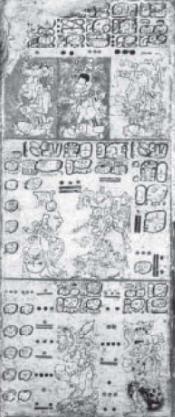
If the Maya didn’t expect the end of time in 2012, what exactly did they predict for that year?
Many scholars who’ve pored over the scattered evidence on Maya monuments say the empire didn’t leave a clear record predicting that anything specific would happen in 2012.
The Maya did pass down a graphic though undated end of the world scenario, described on the final page of a circa 1100 text known as the Dresden Codex. The document describes a world destroyed by flood, a scenario imagined in many cultures and probably experienced, on a less apocalyptic scale, by ancient peoples.
Aveni, the archaeo astronomer, said the scenario is not meant to be read literally but as a lesson about human behavior.
He likens the cycles to our own New Year period, when the closing of an era is accompanied by frenetic activities and stress, followed by a rebirth period, when many people take stock and resolve to begin living better.
In fact, Aveni says, the Maya weren’t much for predictions.
“The whole timekeeping scale is very past directed, not future directed,” he said. “What you read on these monuments of the Long Count are events that connected Maya rulers with ancestors and the divine.
“The farther back you can plant your roots in deep time the better argument you can make that you’re legit,” Aveni said. “And I think that’s why these Maya rulers were using Long Count time.
“It’s not about a fixed prediction about what’s going to happen.”
HOLLYWOOD MILKS MAYAN ARMAGEDDON
Now, enter Hollywood . . .
Considering the fact that end of the world predictions are always popular (44 predictions about the world’s impending doom have been made from 30 AD till 1903 AD), Hollywood always takes the most interesting and worthy of subjects and turns them into hysterical hype. Sad, but true. What was truly “hitting below the belt” was the way in which Hollywood marketed the movie. Something called “viral marketing” was effectively used to multiply the fear factor.
The first stage in this deception drama was the establishment of the Institute for Human Continutiy. The following notice was posted on the website of this fictitious institute. (Check the box below)
One marketing expert explained why they call this type of marketing “viral.”
The term “viral marketing” is offensive. Call yourself a Viral Marketer, and people will take two steps back. I would. “Do they have a vaccine for that yet?” you wonder. A sinister thing, the simple virus is fraught with doom, not quite dead yet not fully alive, it exists in that nether genre, somewhere between disaster movies and horror flicks.
But you have to admire the virus. He has a way of living in secrecy until he is so numerous that he wins by sheer weight of numbers. He piggybacks on other hosts and uses their resources to increase his tribe. And in the right environment, he grows exponentially. A virus doesn’t even have to mate it just replicates, again and again with geometrically increasing power, doubling with each iteration:
1
11
1111
11111111
1111111111111111
11111111111111111111111111111111
11111111111111111111111111111111111111111111111
In a few short generations, a virus population can explode.
This is exactly what has happened. Even those who thought that the movie was pure nonsense still appreciated the special effects and thus kept on talking about the movie in their blogs, on Twitter and everywhere else.
Our summary of the whole situation:
Fool me once (Y2K), shame on you.
Fool me twice (12/21/12), shame on me.
WHAT IS THE VEDIC VIEW?
Vedic Time
The Vedic system of the four yugas presents the lengths of the ages as 4, 3, 2, and 1 times an interval of 432,000 years. That means the first age lasts 1,728 million years; the second lasts 1,296 million years; the third lasts 864,000 years and the present age lasts 432,000 years. Obviously this system has little resonance with our current theories of human history.
The Vedic version contradicts our present conceptions about not only human antiquity but also human longevity. At the height of the first age, the life span is listed as 100,000 years. Then it decreases through each of the successive ages by a factor of 10. Thus, in the next age life spans reduce to 10,000 years; then 1000; until in the present age the maximum is stated as 100 years, shrinking to 50 at the end.
A Quick Look at Dating the Present Age
The time is midnight. The date is 18 February, 3102 B.C. Your location is the Indian subcontinent. The seven planets, including the sun and the moon, are invisible, because they are lined up in one direction on the other side of the earth. According to the Vedic supplementary astronomical texts, known as jyotisa sastras, this rare planetary alignment and the specified date of its occurrence marked the beginning of the fourth age.
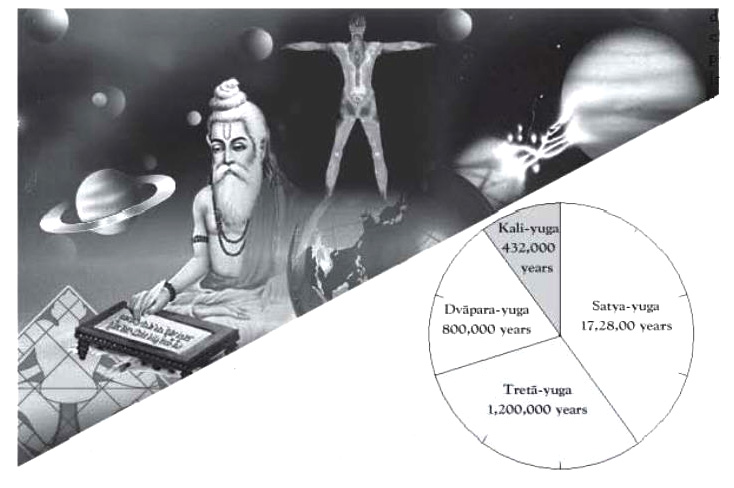
Naturally, the mainstream view of Western scholars is that the date for Kali yuga and its forecast symptoms are figments of the immense Vedic mythic and poetic imagination. Computers and software, however, are coming to the rescue of Vedic integrity. Astronomical software takes the coordinates and dates we enter and then displays approximations of the sky as our remote ancestors saw it. Today calculations are underway that strongly support the Vedic picture of the skies in 3102 B.C.
An American mathematician, Dr. Richard Thompson, specializing in probability theory and statistical mechanics, has devoted himself to analyzing ancient Vedic cosmology. He writes in his book Vedic Cosmography and Astronomy:
“We would suggest that the dating of the start of the present age (called Kali yuga in the Vedas) at 3102 B.C. is based on actual historical accounts, and that the tradition of an unusual alignment of the planets at this time is also a matter of historical fact. The opinion of the modern scholars is that the epoch of Kali yuga was concocted during the early medieval period. According to this hypothesis, Indian astronomers used borrowed Greek astronomy to determine that a near planetary alignment occurred in 3102 B.C. After performing the laborious calculations needed to discover this, they then invented the fictitious era of Kali yuga and convinced the entire subcontinent of India that this era had been going on for some three thousand years. Subsequently many different Puranas were written in accordance with this chronology, and people all over India became convinced that these works were really thousands of years old.”
One might ask why anyone would even think of searching for astronomical alignments over a period of thousands of years into the past and then redefining the history of an entire civilization on the basis of a particular discovered alignment. It seems more plausible to suppose that the story of Kali yuga is genuine, that the alignment occurring at its start is a matter of historical recollection, and that the Puranas really were written prior to the beginning of this era.
Fatalism and the Vedas
A popular misconception is that inevitability and predetermination stifle Vedic culture, suppressing the human capacity for creative initiative and opportunism. Many think the Vedic cycles share the fatalism associated with Babylonian, Egyptian, and Mayan cosmologies. Stanley Jaki, a Benedictine priest who holds doctorates in both physics and theology, has made an extensive study of time in ancient cosmology. He compares the Vedic cycles to an inescapable treadmill, which transfixes the people in a stupor of resignation and powerlessness. Therefore, he opines, the hallmark of Vedic culture is despair and despondency.
Jaki tells us the story of a Mayan people, the Itza, whose leaders informed two Spanish missionaries that on a particular date eighty years in the future, an age of calamities would beset the tribe. The missionaries devotedly informed the conquistadors. Right on schedule eighty years later a small contingent of Spanish soldiers appeared. The Itza, though well armed and numerically superior, immediately surrendered without a fight. This docility in the face of predetermined adversity is said to hamper all cyclic cultures.
Nothing could be further from the Vedic truth. The Vedas emphasize our executing prescribed social, familial, and occupational duties in all circumstances whether the tide is with you or not. Vedic culture does not bind us to an inescapable treadmill of despair and despondency. Instead, it offers the joyous key to something immeasurably superior. Vedic seers want us to grasp that material existence as a whole is deadening whether cyclic or linear, heavenly or miserable. The entirety of matrerial existence is the dreary treadmill. But perhaps because we know nothing better, we do protest when material existence is devalued.
CONCLUSION
To begin with, there is no harm in getting a good weather report. The Vedic presentation of Kali yuga purports to be just that. A modest, restrained approach to the world of yuga cycles would be to see how much the predictions of Kali yuga are actually visible in today’s world.
When people hear that rain is forecast, they carry an umbrella. But still they energetically go about their affairs. Foreknowledge of impending disasters would most likely increase their effectiveness, not decrease it.
Syamananda Dasa serves as the editor for monthly English and Marathi editions of Back to Godhead magazine.
